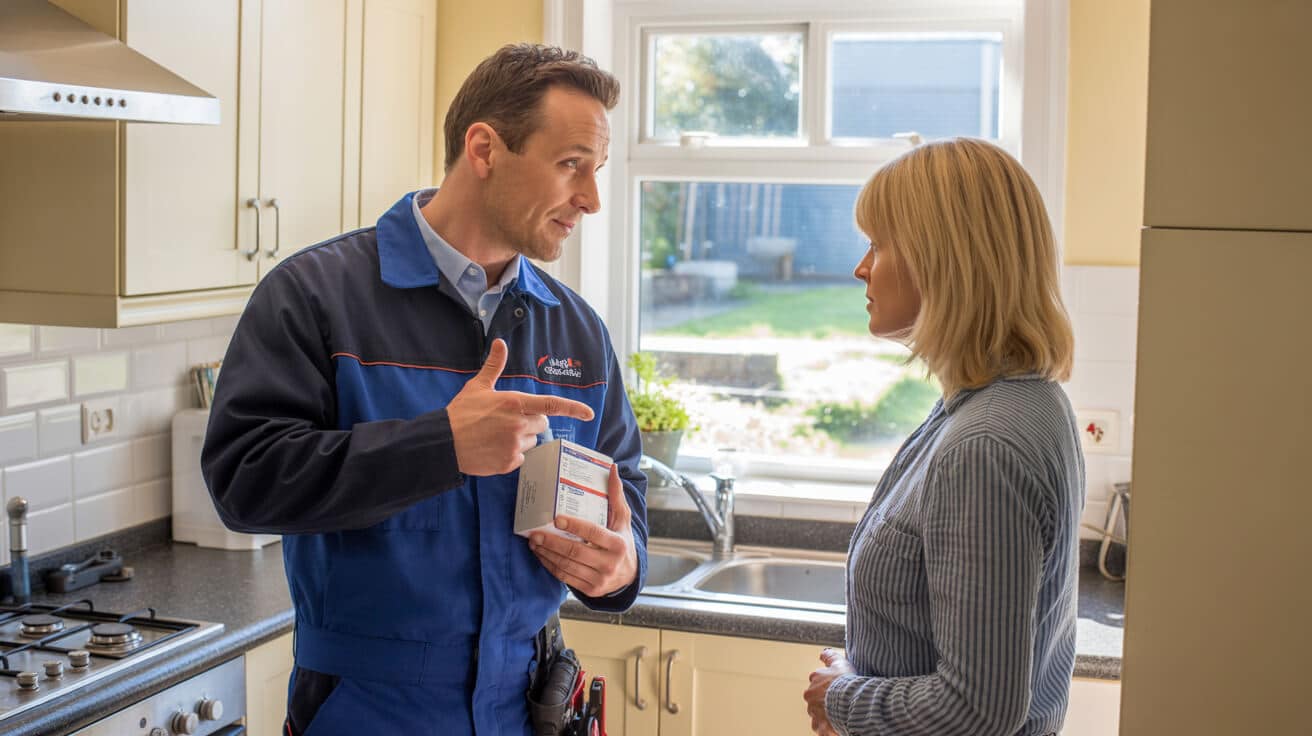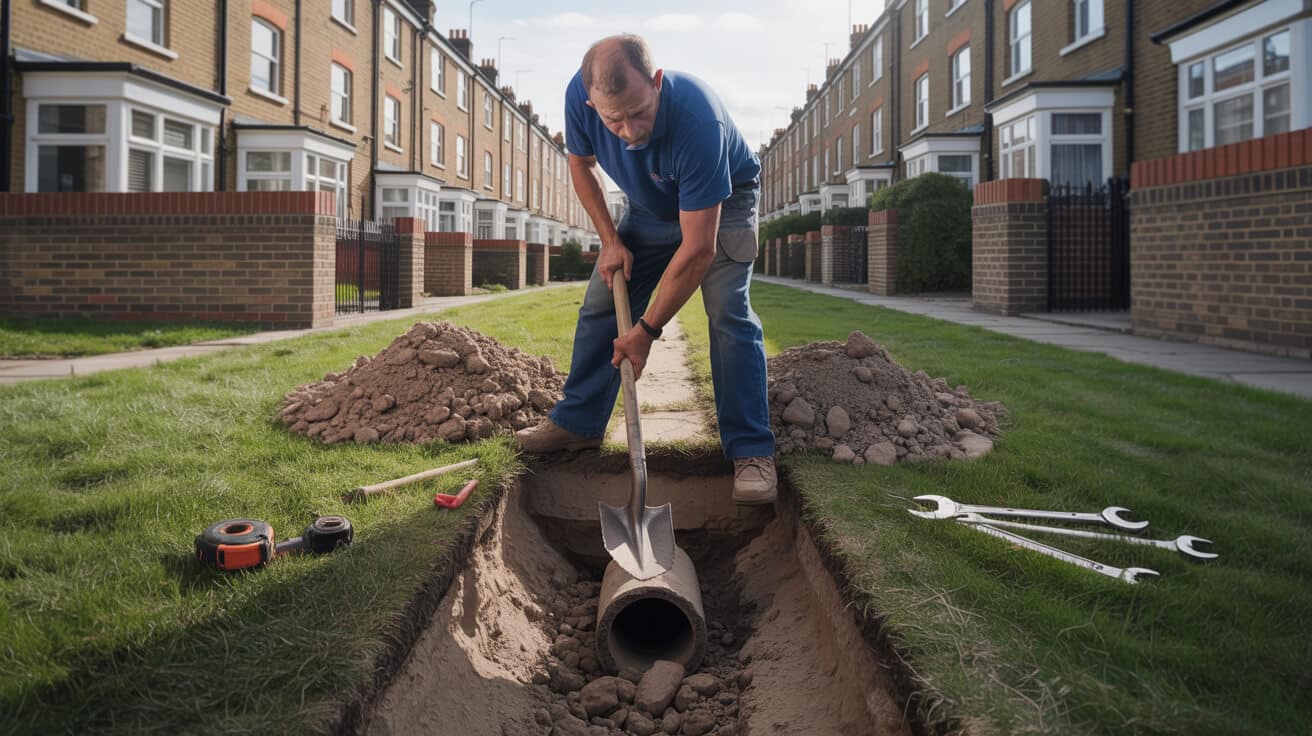 Smart Thermostats Explained – Are They Worth It
Smart Thermostats Explained – Are They Worth It

Why Are UK Homeowners Rethinking Heating Control—and Who Actually Benefits From Smart Thermostats?
In the shadow of steeply rising energy bills across the UK, heating is doing more than burning holes in your wallet—it’s shaping landlord decisions, stressing managing agents, and keeping local authorities up at night. With over half of the UK home’s annual energy bill—between £1,250 and £1,400—allocated to heating and hot water (Ofgem, 2023), the old way simply isn’t holding up. Most properties still lean on outdated manual thermostats, basic timers, or fixed programmes—systems that quietly reward forgetfulness and penalise anyone who isn’t glued to the controls around the clock.
Most people don’t realise they’re leaking money each winter—until the bill arrives and it’s too late to do anything about it.
But this isn’t merely about saving pounds and pence. It’s about gaining certainty and making sure heating systems serve your schedule—not the other way round. As energy prices fluctuate and pressure mounts on EPC standards, Minimum Energy Efficiency Standards (MEES), and grant eligibility, property owners and asset managers face silent but very real compliance risk. Every heating cycle you forget to switch off or timer that runs on when nobody’s home is wasted cost, wasted energy, and, for many, a step closer to falling foul of current or future legislation.
The surge towards smart thermostats is less “gadget hype” and more a sign of strategic thinking. Owners and landlords know that a certified, commissioned smart system offers more than a mobile app—that combination of learning routines, zoning, remote access, and a full compliance handover isn’t just new tech. It’s future-proofing, reputation-building, and control in the hands of the actual decision-maker.
The professionals are winning trust:
Energy Saving Trust reports a decisive shift among UK homeowners and property managers towards certified, WRAS/WaterSafe-accredited installers—moving away from DIY or “gadget shop” fits that risk non-compliance, warranty voids, and guesswork savings (Energy Saving Trust, 2023).
What are people actually worried about?
- Compatibility and wiring headaches: Will it work with my current boiler or systems? Will the smart device “play nice” with OpenTherm, legacy wiring, or underfloor loops?
- Doubt about true savings: Is the “up to 20%” figure possible, or another sales line?
- Fear of a tech takeover: Will app glitches or complicated routines mean losing control or leaving vulnerable tenants shivering?
- Compliance anxiety: Can DIY or shortcut installations fail landlord insurance, grant applications, or even invalidate EPC and MEES?
Upgrading through a certified, documented process eliminates all four, swapping guesswork for assurance.
What Actually Is a Smart Thermostat—And Why Does Certified Installation Matter?

“Smart” in heating gets thrown about, but it’s less about the app and more about making your system think for you. Smart thermostats behave as the brain of your heating, learning your schedule, adjusting to your presence, and responding to changes inside and outside the property. When fitted by a certified engineer—someone with G3, WRAS, and Part P credentials—you get a sharp line between “gadget on the wall” and “system that runs itself, reliably, for years.”
A good smart system fades into the background—your comfort stays consistent, your documentation is ready, and regulation never trips you up.
De-mystifying the tech
- Remote access: Dial your heating up (or down) from your phone, whether you’re at the office, on the train, or halfway round the world.
- Adaptive scheduling: The device learns from your real routines—out late, holiday, school runs, or odd shifts—minimising dead heat and waste.
- Geo-fencing: The heating notices when the property empties, scaling down automatically; it fires back up as people approach home. No more “all-day” timers blazing for empty rooms.
- Room-by-room zoning: With the right valves and controls, only the spaces in use get heated. Kids’ rooms stay cold during daylight; work-from-home zones heat up only between nine and five.
Why does certified installation really matter?
- Hidden complexity: From figuring out S-plan and Y-plan circuits, OpenTherm compatibility, or integrating underfloor controls and secondary pumps—improper wiring or setup leads to expensive, sometimes dangerous faults.
- Protection against voided warranties and insurance nightmares: Most insurers and manufacturers require accredited fitting—getting this wrong is often invisible until a claim or audit.
- Easy compliance handover: Certified installers like Plumbers 4U provide full documentation—photos, step-by-step guides, login records, and clear instructions. This pack is gold for landlords, letting agents, or any future asset file.
A true upgrade is only “smart” if it’s planned, fitted, and tested the right way. Anything else is like fitting a F1 engine with bicycle brakes—potential, but too risky for the stuff that counts (comfort, safety, value, and compliance).
Do Smart Thermostats Truly Cut Energy Costs and Emissions—Or Is It Clever Marketing?

The boldest claims don’t come from the packaging; they come from audited bills and cold, hard data. Smart thermostats delivered and set up by an experienced, credentialed installer routinely achieve 10–20% savings on annual heating spend—£200 to £267 a year for the average property (ScottishPower, Tado°, multiple studies). That result comes through proper diagnosis, expert zoning, and tuning comfort rules to real occupant patterns, not a standard “auto schedule.”
The secret isn’t the gadget—it’s the expert who matches system to property, and proves it with every bill.
What’s behind the savings?
- No “dead heat” losses: Learning and occupancy features stop heating empty rooms or floors. Only the places in use ever see energy spent.
- Adapts to seasons and habits: Smart stats tweak runtime based on outdoor temperature, sun exposure, and internal sensors to deliver comfort at lower cost.
- Precision zoning: Larger properties, HMOs, and multi-tenant buildings can see outsized savings from custom zones—heating only the places that matter, exactly when needed.
But simply swapping out a stat, without analysing legacy wiring, loop points, or customer routines, often leaves major savings off the table. Professionals perform a line-by-line diagnosis—identifying open circuits, old “dead” stats, or incorrect valve positions that marketing rarely explains.
Show, not tell—proof is key:
Installers who commit to photo evidence, energy logs, and thorough handovers build a trust asset that lasts long after the invoice. This is now the gold standard for property managers and asset owners handling repairs, grants, or regulatory reviews.
Does Choosing Smart Mean Losing Control—or Gaining Real Comfort?

Maybe the biggest roadblock for hesitant owners and property managers: the belief that “smart” means handing power over to a black box. With the right setup, it’s the opposite—smart controls return power to users of every age and tech comfort level.
Comfort isn’t about more buttons—it’s about always being able to override, adjust, and trust you’re getting exactly what you paid for.
How does a smart instal keep you in charge?
- Multiple control paths: Voice pods, physical dials, and old-school buttons all work, not just the app. Lose the WiFi? The wall stat still works.
- All-access handover: Certified installers make user guides, demonstrate step by step, and include photos or videos of real controls—not generic manual screenshots.
- Ongoing support: With Plumbers 4U, aftercare is standard: every instal is logged, and the support line never leaves you on your own when the app updates, or if you lose a password.
User training and documentation
Success rides on showing—not just telling—every user how the system works. That means hands-on walk-throughs at handover, printed or digital cheat sheets, and a real person to call if settings are forgotten. True smart equals no support nightmares, just seamless comfort regardless of age or technical background.
Peer reviews, forums, and real asset managers echo this: the only upgrades that build loyalty are those that document and demo every claim, and are backed by reliable people. Plumbers 4U mandates this approach for every job, regardless of the property size.
What Goes Wrong with Smart Thermostat Instals, and How Do Experts Prevent Catastrophe?

Cut-corners and guesswork are the main reasons smart upgrades sour. Unchecked legacy wiring, missed zoning quirks, or WiFi-only setups tank potential savings and breed endless tenant phone calls. Every estate agent and landlord has a horror storey about an “easy” DIY smart fit gone awry—systems that lock out users, leave rooms unheated, or worse, quietly void insurance and warranty cover.
Most big headaches are caused by one misunderstood cable, a forgotten valve, or leaving setup documentation in the van.
What expert installers safeguard against
- Hardware and boiler conflicts: OpenTherm, S-plan, and hybrid systems need specific control logic. Without checking valve layouts and boiler logic—or mapping out underfloor heating—DIYers risk expensive repairs or even full re-wires.
- Connectivity and security: Certified fits include protocol-level WiFi tests, backup control mapping, and up-to-date firmware. Renters and landlords especially need password handover and app setup done on-site, not left to chance or assumption ([TechnologyInnovate, 2023](https://technologyinnovate.com/is-your-smart-thermostat-a-backdoor-for-hackers/)).
- Legal documentation: Each system receives a handover pack—commissioning sheets, photos, login details, and tenant/landlord guidance. Crucial for EPC inspection, new tenant onboarding, or repairs—one missing folder can mean years of headaches.
- Non-standard instals: Odd wiring, split systems, obscure “eco” function quirks—pros spot these before they snowball into tenant complaints or heating breakdowns mid-winter.
Takeaway:
The right pro doesn’t drop the kit and disappear: every Plumbers 4U engineer logs before and after photos, fills compliance folders, and ensures the system genuinely works for every user, not just in perfect lab conditions.
DIY vs. Pro: When Does Smart Heating Demand a Specialist, and What’s On the Line if You’re a Landlord?

DIY might look cheap in the short term, but smart heating’s not like hanging a shelf. Electrical regulation (Part P), water reg (WRAS), unvented systems (G3), and rental property compliance all have specific, often invisible, requirements. Stakeholders—including managing agents and landlords—are now judged by the documented, compliant performance of these upgrades.
The money you save on DIY is often dwarfed by what you lose to failed audits, voided warranties, and unhappy tenants.
Alarm bells: when DIY won’t cut it
- Multi-zone heating: If your property has more than one loop, underfloor runs, or hybrid with renewables, only a qualified installer can spec and prove safety.
- Unvented cylinders or advanced wiring swaps: G3 and Part P certification is a legal demand, not a “nice to have.” Lapses here mean denied insurance, refused grants, or failed property let/rental sign-offs.
- Asset management and compliance: For landlords and property managers, documentation is the shield. Professional instals bundle before/after photos, clear logs, and a support line—DIY skips all.
- Long-term liability: If a system fails and there’s no trail, EPC and grant claims can evaporate. Quality paperwork now underpins capital value in letting and asset sales.
Where Plumbers 4U stands apart:
Every badge—WRAS, WaterSafe, TrustMark, CSCS, G3, Part P—is visible for every job, with documentation to match. Landlords, asset managers, and agents gain a ready-built audit trail and aftercare, with proof at every handover.
Which Thermostat Brands Actually Deliver—And Why Is “Compatibility” Often Underrated?

Some brands own social feeds, but what serves real homes is compatibility and the engineer’s expertise—not the size of a tech company’s marketing campaign. The best fit for your property isn’t always “universal”—in unique wiring scenarios or with certain boiler brands, inexpert choices backfire.
A thermostat is only as smart as the installer who checks everything from valve setup to EPC requirements—before you spend a penny on the box itself.
Practical brand and compatibility breakdown
| System Type | Core Benefit | Caution |
|---|---|---|
| Universal (Nest, Hive, Tado, Drayton Wiser) | Works with most modern boilers, feature-rich apps, modular upgrades | May need adapters and advanced wiring for legacy setups or full function |
| Boiler-branded (Vaillant vSMART, Ideal Halo, Worcester EasyControl) | Streamlined setup, manufacturer warranty integration, advanced self-diagnosis | Manufacturer lock-in—may not transfer to a future boiler switch or multi-fuel integration |
An engineer worth their salt doesn’t just sell the box—they match property, boiler, system quirks, and legal roadmap to the right system. Grants, insurance, and property sales now all probe for proper commissioning and compatibility—it’s not about a logo anymore.
Documentation yields long-term value
- Commissioning folder: Full set of wiring diagrams, installer notes, logins, and operating guides.
- Change-of-ownership or tenancy pack: Shows compliance and guarantees function for new users and grants applications.
Demand this from any instal—Plumbers 4U makes it baseline.
What Steps Turn Smart Heating Into Tangible Comfort and Savings—for Every Stakeholder?

Futureproof heating value relies on process, not just product. That means pre-upgrade diagnosis, transparent quotes, certified work, documented handover, and real aftercare. Saving energy, avoiding fines, and protecting value all start before you instal a single stat.
Plumbers 4U’s process, start to finish
- Open, written quotations: Nothing left off the page.
- Certified plumbing and heating experts: Every job confirmed by WRAS, WaterSafe, TrustMark, CSCS, G3, and Part P engineers.
- Comprehensive handover pack: Photos, documentation, guides, and compliance logs—ready for tenancy, asset management, or property sale audit.
- Support for every system: From modern OpenTherm to legacy wiring, underfloor loops, or hybrid electric.
- Aftercare line: Whether it’s a nippy cold snap or future upgrades, support is a call, message, or WhatsApp away. No “DIY and disappear” here.
No homeowner, landlord, or manager should have to chase paperwork or heating tweaks. With the right installer, every critical proof is ready the day you need it.
Book a survey and compatibility check: get a line-by-line breakdown, a compliance pathway, and judgement-free support from installation to audit.
Get a Smart Heating System That Works for You—No Guesswork, No Surprises
When only documented performance, EPC security, and real, proof-backed guarantees matter, Plumbers 4U brings a team built on trust and relentless expertise. We deal in comfort, compliance, and a service trail you can rely on—today and every winter ahead.
- Credentials upfront: WRAS, WaterSafe, TrustMark, CSCS, G3, Part P—visible, not hidden.
- Transparent, line-itemed quotes: No surprise extras.
- Hand-in-hand commissioning: Before/after photos, login guides, full setup folders.
- One-stop compliance handling: EPC, Part P, G3, and landlord or grant paperwork solved in the same visit.
- Planned aftercare: WhatsApp, phone, or email support and reminders—no unanswered questions.
- Hundreds of five-star reviews, thousands of satisfied instals, and not a single walkaway job.
Your heating shouldn’t be another headache or a compliance gamble. Choose Plumbers 4U for installations that deliver peace of mind, not just kilowatt hours.
Schedule your full property survey today, and guarantee heating that works with you—and for you.
Frequently Asked Questions
Who benefits most from installing a smart thermostat in their UK property?
A smart thermostat pays dividends to anyone juggling unpredictable schedules, rising bills, or compliance pressure—especially UK homeowners and landlords managing more than a single space. Large families, HMO operators, multi-let managers, and busy landlords with remote tenancies all see the sharpest return, not just on cost but on day-to-day oversight and regulatory readiness.
In an average UK house, heating alone consumes more than half of total energy spend—often exceeding £1,250 a year (Ofgem, 2023). Traditional timers or static controls simply can’t keep up. Smart thermostats fill the blind spots: they adapt to irregular work patterns, weekend guests, late returns, and the “who forgot to turn off the heat” routine. Landlords and property managers get an extra edge: every step toward efficiency can nudge EPC grades higher, open eligibility for grants, and ensure ongoing MEES compliance.
Controlling heat by habit leaves money behind—smart controls reclaim it, silently and without the drama.
Which property profiles gain the most value?
- Homes with young families or shared uses, where rooms heat and cool at odd times
- Portfolios with HMOs, blocks, or mixed residential lets—especially those requiring remote oversight
- Landlords and managers with audit-ready, compliance-driven mandates
- Owners seeking long-term resale edge, EPC improvement, or grant access
- Operations where staff, visitors, or tenants change routines unpredictably
A smart thermostat doesn’t just suit the tech-minded—it’s a lever for anyone forced to do more with less in the realm of energy, compliance, or duty of care.
How much money and energy do smart thermostats really save in practice—and who sees the quickest payoff?
UK users fitting a smart thermostat commonly cut 10–20% from their annual heating spend, adding up to £100–£270 saved per property each year, according to the Energy Saving Trust and sector-wide field studies. Larger, busier homes, rental blocks, or any property with offbeat heating habits reap the quickest tangible gains.
Properties that consciously use “occupancy detection,” time-of-use schedules, and room-by-room zoning unlock the top end of these savings. For households where heating is often left running overnight or “just in case,” the return on investment can arrive within 1–2 cold seasons. Portfolio landlords and commercial operators—whose bottom line is hit by every hour of wasted warmth—see the rewards mount even faster.
| Scenario | Typical Annual Savings | Payback Window |
|---|---|---|
| 5+ person/zone homes, HMOs, blocks | £180–£270 | 1–2 years |
| Lean, solo-occupant flats | £80–£140 | 2–3+ years |
| Multi-let or high-turnover rentals | £200+ | 1–2 years |
Engineered installations achieve the most: mapping actual use, zoning logic, and system quirks keeps savings ticking years on. DIY instals often miss out on both energy reduction and warranty protection.
Savings don’t come from ‘tech for tech’s sake’—they’re built with sharp setup, ongoing checks, and features tied to the reality of your building, not a brochure.
Well-chosen stats become a silent asset—not only cutting the first bill, but compounding into every winter’s savings, audit, or regulatory upgrade thereafter.
Which types of heating systems and boilers in the UK work best (or worst) with smart thermostats?
Most modern heating systems—combi, system, or heat-only boilers—are ready for smart stats straight away, but hidden traps exist, and missing them costs both comfort and compliance.
Supported systems—and their telltale restrictions
- Combi Boilers: Almost all smart stats (Nest, Hive, Tado, Drayton, brands’ own) work here. OpenTherm compatibility supercharges efficiency, so confirming both boiler and stat compatibility is key.
- System/Regular Boilers: Most setups allow smart control, but homes using cylinders for hot water (S-plan or Y-plan) sometimes require extra relays or wiring splits—tasks for a certified installer.
- Manufacturer Systems: Using models like Vaillant vSMART, Worcester EasyControl, or Ideal Halo with their matching boilers brings diagnostic data and warranty perks, but may “lock” you into upgrade paths.
- Underfloor and Hybrid Heating: System sprawl, multiple zones, or mixed tech demand specialist wiring, valve mapping, and compliance attention—always a job for someone WRAS, G3, and TrustMark certified.
- Older Gravity-fed or Non-standard Systems: Pre-2000s setups, or anything with “bespoke” controls, could block fitment due to voltage mismatches or unavailable relays. Survey-first is a must.
- Heat Pumps/Electric Storage: Niche, often requiring brand-specific controls or adapters, with fit verified case-by-case.
A no-obligation, engineer-led survey exposes unseen wiring, zoning logic, or relay gaps—securing proper function before investment.
| System Type | Fit for Smart? | Issues to Assess |
|---|---|---|
| New combi (OpenTherm/standard) | Yes | Protocol match, wiring |
| System/regular | Yes (relay check) | S-/Y-plan, cylinder controls |
| UFH, hybrid/mixed | Often (plan needed) | Multi-zone, valve mapping |
| Older gravity-fed | Survey required | Relay, voltage compatibility |
| Electric/Heat pump | Specialist only | Adapter, firmware, support |
Compatibility is 90% planning, 10% tech—mistakes lead to headaches that cost more than they save.
Professional mapping means you avoid both wasted investment and “patch it later” pitfalls.
Where do hidden risks, compliance issues, or privacy challenges catch UK smart thermostat adopters off-guard?
Major stumbling blocks aren’t usually technical—but arise from rushed instals, missing paperwork, security oversights, or misunderstanding how usage data and platform costs play out long-term.
- Platform Lock-in: Premium features, app integrations, or “walled garden” brands may carry surprise subscription or module fees—itemised, fixed quotes avoid regret.
- Privacy & Data: Thermostats log schedules and occupancy. The regulatory onus (GDPR) falls on property managers and landlords in multi-let or surveillance-sensitive situations. Only 1 in 7 property operators probes the fine print *(Forbes, 2023)*.
- DIY Warranty Risk: Insurance, manufacturer, or even home warranty claims may be denied if instal steps, documentation, or certification fall short. Poor logging or skipped compliance checks are the landlord’s nemesis.
- Incomplete Handover: Missed app setups, default passwords, or hidden Wi-Fi issues lead to callouts, tenant complaints, or security breaches—certified engineers must document settings and train users.
- MEES/EPC Trouble: Poorly chosen or fitted controls can stall a property’s efficiency grade or fail audits—especially as standards tighten across England and Wales.
All pitfalls narrow with professional installation: secure handover, GDPR protection, and a fix list that guarantees every regulatory angle is covered from day one.
Every skipped fit, unchecked policy, or ‘set and forget’ approach multiplies future hassle—compliance, grants, and claims all demand that first evidence trail.
Careful contractors future-proof both building and paperwork.
What do certified installers like Plumbers 4U deliver that “DIY” or e-commerce kits simply can’t match?
Professionals offer more than wiring know-how—they deliver end-to-end risk cover, training, documentation, and future flexibility. It’s what turns a gadget into a long-term asset, not just a one-off purchase.
- Whole-System Survey: Tracing every relay, valve, and legacy wire avoids misfit, incomplete zone coverage, or “zombie” radiators left off the control map.
- Transparent, Line-Item Quotes: Costs, parts, and any required upgrades all spelled out before work begins—no “extras” on the day.
- Photo-logged Instal + User Induction: Every stage is snapped, password-protected, and stored, with live demonstration for all building users.
- Compliance & Audit Trail: Generates digital and hardcopy manuals that withstand grant, EPC, MEES, or insurance audits—vital for landlords and portfolio managers.
- Future-Proof Support: Firmware, app, and regulatory changes are covered with scheduled aftercare, keeping systems performing and compliant across upgrades or building change.
Engaging Plumbers 4U means taking control—no more guesswork, loopholes, or surprise costs, just a property that’s ready for today’s needs and tomorrow’s demands.
An untrained instal risks your comfort, compliance, and wallet—but a top engineer brings you peace of mind from boiler room to boardroom.
For properties with serious ambitions, only a trusted, certified engineer unlocks the full suite of warranty, savings, and compliance—protecting your interests year after year.
Which features, brands, and installation choices create superior long-term value for UK smart thermostats?
Not all features, brands, or fitment practices are equal. OpenTherm capability, room-by-room zoning, compliance audit trails, and app-driven troubleshooting make the most lasting difference.
- OpenTherm Modulation: Ensures boilers “dial down” not just on/off—delivering maximum efficiency, reduced wear, and lower emissions. Only some boilers and stats support it; pro verification is essential.
- Smart Zones + TRVs: Enables true room-by-room control, major value for HMO managers, families, or anyone with mixed-use spaces. Reliable brands: Tado, Drayton Wiser, Honeywell Evohome, plus major boiler-branded stats.
- Platform Reliability: Apps that work across devices, with clear warranty support, and compliance proof should be the baseline—brand lock-in weighs against future flexibility.
- Compliance-Ready Documentation: Pro-fitted, photo-logged, and WRAS/G3 certified instals mean warranty protection, insurance eligibility, and grant access stay solid regardless of owner changes or new legislation.
- Manufacturer-Matched vs. Universal: Proprietary systems (Vaillant, Worcester, Ideal) ensure seamless support; universal stats offer more brand freedom. The right pick answers the needs of both today and whatever upgrades may follow.
A certified Plumbers 4U engineer appraises your situation and matches features to real needs—not sales hype.
| Feature or Asset | Value Delivered | Best Use Case |
|---|---|---|
| OpenTherm modulation | Max energy control/reliability | Busy homes, newer boilers |
| Multi-zone/TRV control | Room-by-room savings/comfort | Large homes, HMOs, blocks |
| Audit/Compliant instal | Warranty/proof long-term | Landlords, grant seekers |
| Brand-locked integration | Seamless support, smart app | Manufacturer-matched sites |
| Universal stat | Brand freedom, easy upgrades | Mixed boilers, future swaps |
Features pay back for years if paired, installed, and maintained in tune with your property’s evolving profile.
Book a free, audit-ready smart stat consult with a Plumbers 4U engineer to secure savings, legal readiness, and comfort for every heating season ahead.



